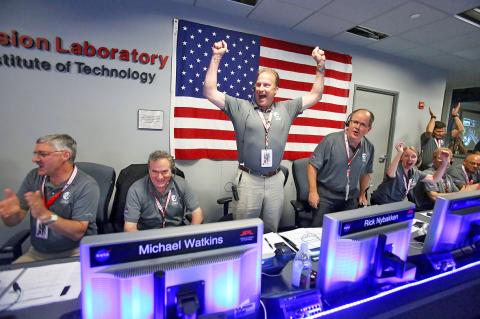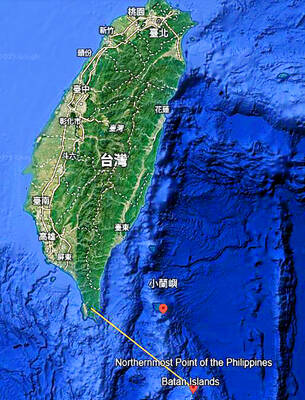NASA’s Juno spacecraft capped a five-year journey to Jupiter late on Monday with a do-or-die engine burn to sling itself into orbit, setting the stage for a 20-month dance around the biggest planet in the solar system to learn how and where it formed.
“We’re there. We’re in orbit. We conquered Jupiter,” lead mission scientist Scott Bolton, with the Southwest Research Institute in San Antonio, told reporters yesterday. “Now the fun begins.”
Juno is to spend the next three months getting into position to begin studying what lies beneath Jupiter’s thick clouds and mapping the planet’s gargantuan magnetic fields.

Photo: AFP
Flying in egg-shaped orbits, each one lasting 14 days, Juno is also set to look for evidence that Jupiter has a dense inner core and measure how much water is in the atmosphere, a key yardstick for figuring out how far away from the sun the gas giant formed.
Jupiter’s origins affected the development and position of the rest of the planets, including Earth and its fortuitous location conducive to the evolution of life.
“The question I’ve had my whole life that I’m hoping we get an answer to is ‘how’d we get here?’ That’s really pretty fundamental to me,” Bolton said.
Jupiter orbits five times farther from the sun than Earth, but it might have started out elsewhere and migrated, jostling its smaller sibling planets as it moved.
Jupiter’s immense gravity also diverts many asteroids and comets from potentially catastrophic collisions with Earth and the rest of the inner solar system.
Launched from Florida nearly five years ago, Juno needed to be precisely positioned, ignite its main engine at exactly the right time and keep it firing for 35 minutes to become only the second spacecraft to orbit Jupiter.
If anything had gone even slightly awry, Juno would have sailed helplessly past Jupiter, unable to complete a US$1 billion mission.
The risky maneuver began as planned at 11:18pm on Monday as Juno soared through the vacuum of space at more than 257,500kph.
NASA expects Juno to be in position for its first close-up images of Jupiter on Aug. 27, the same day its science instruments are turned on for a test run.
Only one other spacecraft, Galileo, has ever circled Jupiter, which is itself orbited by 67 known moons.
Bolton said Juno is likely to discover even more.
The risks to the spacecraft are not over. Juno is to fly in highly elliptical orbits that are to pass within 4,800km of the tops of Jupiter’s clouds and inside the planet’s powerful radiation belts.
Juno’s computers and sensitive science instruments are housed in a 180kg titanium vault for protection.
However, during its 37 orbits around Jupiter, Juno will be exposed to the equivalent of 100 million dental X-rays, said Bill McAlpine, radiation control manager for the mission.
The spacecraft is expected to last for 20 months. On its final orbit, Juno will dive into Jupiter’s atmosphere, where it will be crushed and vaporized.

SECURITY: As China is ‘reshaping’ Hong Kong’s population, Taiwan must raise the eligibility threshold for applications from Hong Kongers, Chiu Chui-cheng said When Hong Kong and Macau citizens apply for residency in Taiwan, it would be under a new category that includes a “national security observation period,” Mainland Affairs Council (MAC) Minister Chiu Chui-cheng (邱垂正) said yesterday. President William Lai (賴清德) on March 13 announced 17 strategies to counter China’s aggression toward Taiwan, including incorporating national security considerations into the review process for residency applications from Hong Kong and Macau citizens. The situation in Hong Kong is constantly changing, Chiu said to media yesterday on the sidelines of the Taipei Technology Run hosted by the Taipei Neihu Technology Park Development Association. With

CARROT AND STICK: While unrelenting in its military threats, China attracted nearly 40,000 Taiwanese to over 400 business events last year Nearly 40,000 Taiwanese last year joined industry events in China, such as conferences and trade fairs, supported by the Chinese government, a study showed yesterday, as Beijing ramps up a charm offensive toward Taipei alongside military pressure. China has long taken a carrot-and-stick approach to Taiwan, threatening it with the prospect of military action while reaching out to those it believes are amenable to Beijing’s point of view. Taiwanese security officials are wary of what they see as Beijing’s influence campaigns to sway public opinion after Taipei and Beijing gradually resumed travel links halted by the COVID-19 pandemic, but the scale of

A US Marine Corps regiment equipped with Naval Strike Missiles (NSM) is set to participate in the upcoming Balikatan 25 exercise in the Luzon Strait, marking the system’s first-ever deployment in the Philippines. US and Philippine officials have separately confirmed that the Navy Marine Expeditionary Ship Interdiction System (NMESIS) — the mobile launch platform for the Naval Strike Missile — would take part in the joint exercise. The missiles are being deployed to “a strategic first island chain chokepoint” in the waters between Taiwan proper and the Philippines, US-based Naval News reported. “The Luzon Strait and Bashi Channel represent a critical access

Pope Francis is be laid to rest on Saturday after lying in state for three days in St Peter’s Basilica, where the faithful are expected to flock to pay their respects to history’s first Latin American pontiff. The cardinals met yesterday in the Vatican’s synod hall to chart the next steps before a conclave begins to choose Francis’ successor, as condolences poured in from around the world. According to current norms, the conclave must begin between May 5 and 10. The cardinals set the funeral for Saturday at 10am in St Peter’s Square, to be celebrated by the dean of the College